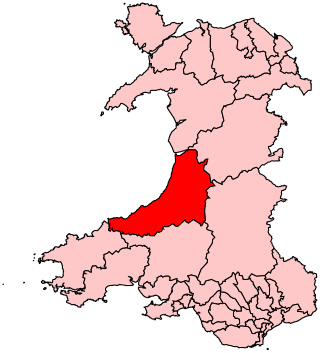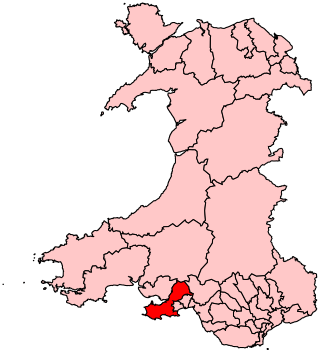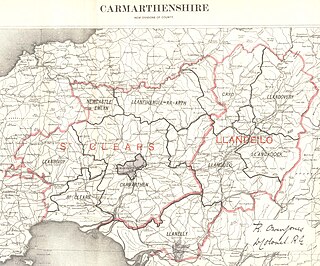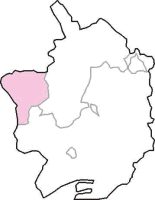Related Research Articles

Ceredigion is a parliamentary constituency represented in the House of Commons of the UK Parliament. Created in 1536, the franchise expanded in the late 19th century and on the enfranchisement of women. Its boundaries remained virtually unchanged until 1983. From 1536 until 1885 the area had two seats : a county constituency (Cardiganshire) comprising the rural areas, the other the borough constituency known as the Cardigan District of Boroughs comprising a few separate towns; in 1885 the latter was abolished, its towns and electors incorporated into the former, reduced to one MP. The towns which comprised the Boroughs varied slightly over this long period, but primarily consisted of Cardigan, Aberystwyth, Lampeter and Adpar, the latter now a suburb of Newcastle Emlyn across the Teifi, in Carmarthenshire.

Gower is a constituency created in 1885 and represented in the House of Commons of the UK Parliament by one Member of Parliament (MP). Tonia Antoniazzi of the Labour Party became its MP after winning it from Conservative Byron Davies in the 2017 UK general election. Her party had previously represented the seat from 1909 until 2015.

Preston is a constituency represented in the House of Commons of the UK Parliament since 2000 by Sir Mark Hendrick, a member of the Labour Party and Co-operative Party.
Swansea was a borough constituency. It was represented in the House of Commons of the Parliament of the United Kingdom. It elected one Member of Parliament (MP) by the first-past-the-post system of election.
Croydon was a constituency in the House of Commons of the UK Parliament from 1885 to 1918. As with most in its lifetime following the Redistribution of Seats Act 1885, it was a seat, that elected one Member of Parliament (MP) by the first past the post system of election.

The 1901 Monmouth Boroughs by-election was a by-election held on 7 May 1901 for the British House of Commons constituency of Monmouth Boroughs.
The 1890 Caernarvon Boroughs by-election was a parliamentary by-election held on 10 April 1890 for the British House of Commons constituency of Caernarvon Boroughs.
The 1910 Swansea District by-election was a parliamentary by-election held for the House of Commons constituency of Swansea District in Glamorgan in South Wales on 28 February 1910.
The 1912 Carmarthen Boroughs by-election was a Parliamentary by-election held in the United Kingdom on 24 January 1912 for the Carmarthen Boroughs constituency in Wales. The constituency of Carmarthen Boroughs was centred on the boroughs of Carmarthen and Llanelli. It returned one Member of Parliament (MP) to the House of Commons of the Parliament of the United Kingdom, elected by the first past the post voting system.
The Manchester South by-election was a Parliamentary by-election held on 5 March 1912. The constituency returned one Member of Parliament (MP) to the House of Commons of the United Kingdom, elected by the first past the post voting system.

The East Carmarthenshire by-election was a Parliamentary by-election held on 22 August 1912. The constituency returned one Member of Parliament (MP) to the House of Commons of the United Kingdom, elected by the first past the post voting system.

Sir Charles Frederick Hutchinson was an English physician and Liberal politician. He was the Member of Parliament (MP) for the Rye Division of Sussex from 1903 to 1906.
The 1917 South Monmouthshire by-election was a by-election held on Thursday 12 July 1917 for the British House of Commons constituency of the Southern Division of Monmouthshire in South Wales.
The 1891 West Derbyshire by-election was a parliamentary by-election held for the House of Commons constituency of West Derbyshire on 2 June 1891.
The 1886 Derby by-election was a parliamentary by-election held for the House of Commons constituency of Derby, the county town of Derbyshire on 9 February 1886.
The 1915 Carmarthen Boroughs by-election was held on 17 March 1915. The by-election was held due to the incumbent Liberal MP, W. Llewelyn Williams, becoming Recorder of Cardiff. It was retained by Williams who was unopposed due to a War-time electoral pact.
The 1914 Swansea District by-election was held on 13 August 1914. The by-election was held due to the incumbent Liberal MP, Sir David Brynmor Jones, becoming Recorder of Cardiff. It was retained by Jones who was unopposed due to a War-time electoral pact.

The West Monmouthshire by-election was a Parliamentary by-election held on 3 November 1904. The constituency returned one Member of Parliament (MP) to the House of Commons of the United Kingdom, elected by the first past the post voting system.
The 1890 East Carmarthenshire by-election was a parliamentary by-election held for the House of Commons constituency of East Carmarthenshire in West Wales in August 1890.
The 1888 Gower by-election was a parliamentary by-election held for the House of Commons constituency of Gower in South Wales in 1888.
References
- ↑ Craig, F. W. S. (1974). British parliamentary election results 1885-1918 (1 ed.). London and Basingstoke: The Macmillan Press Ltd. ISBN 9780333169032. Page xiv
- ↑ David K Brown, Sir Edward James Reed; Oxford Dictionary of National Biography online, OUP 2004-13
- ↑ Who was Who, OUP online, 2007
- 1 2 3 Craig, F. W. S. (1974). British parliamentary election results 1885-1918 (1 ed.). London and Basingstoke: The Macmillan Press Ltd. ISBN 9780333169032. Page 454
- ↑ Matthew Cragoe, Culture, Politics and National Identity in Wales:1832-1886; OUP, 2004 pps 116-117
- ↑ The Times, 22 February 1886 p6
- ↑ The Times, 24 February 1886 p8
- ↑ The Times, 1 March 1886 p7
- ↑ Ian Cawood, The Liberal Unionist Party: A History; I B Tauris, 2012 p317, n143
- ↑ The Constitutional Year Book, 1904, published by Conservative Central Office, page 178 (202 in web page)